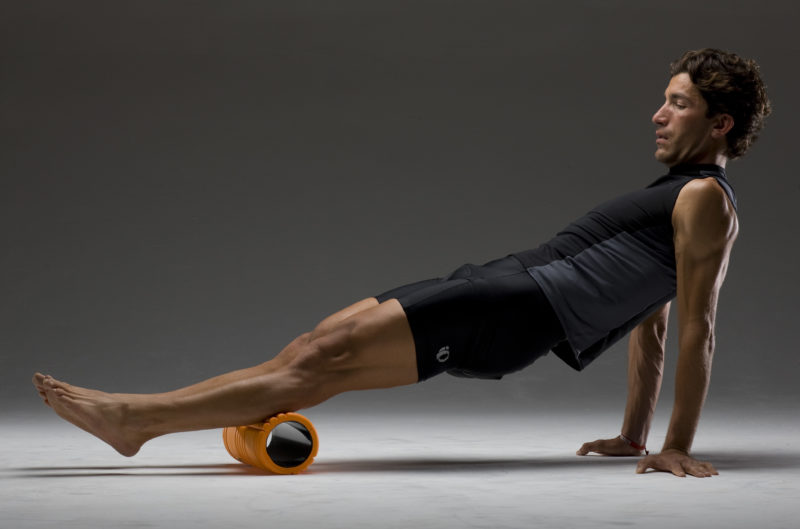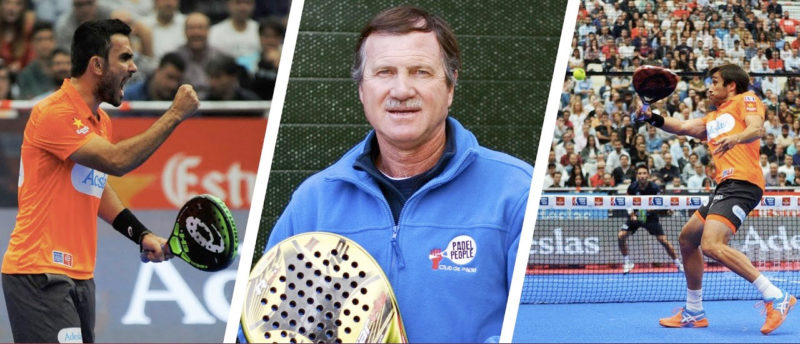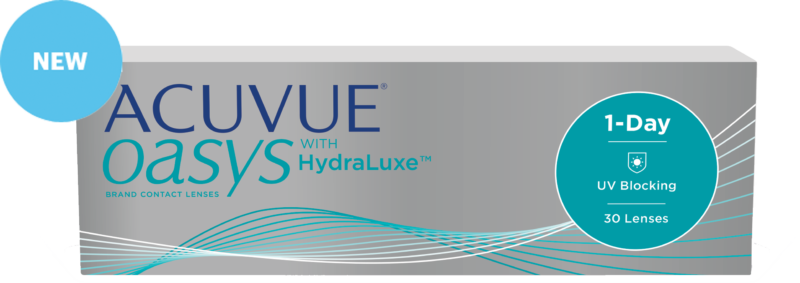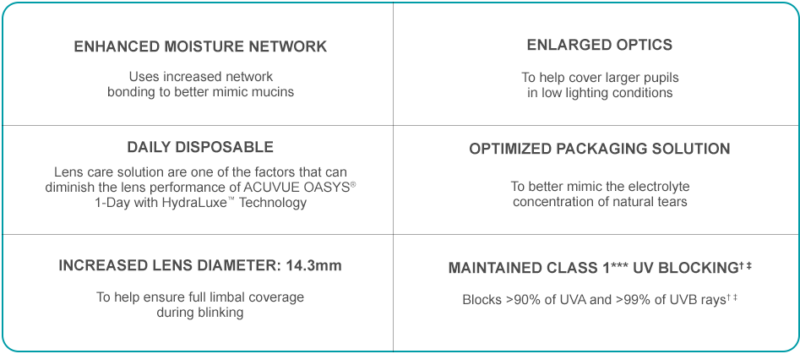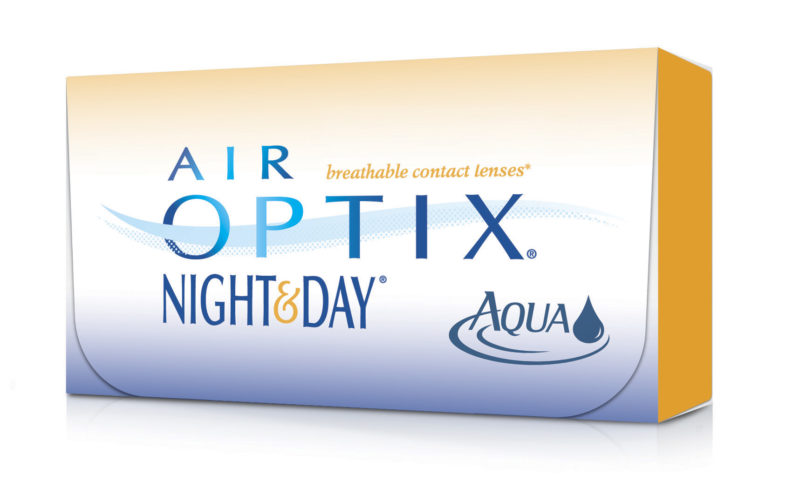
Sleep is one of the most important things we need to take care of in order to live a healthy life and have enough energy to do all the activities we want to do on a daily basis.
When discussing sleep, the first thing we need to learn is that the idea that sleep is just one long state that we enter every night is a false one. Our sleep time is actually broken down into what are called sleep cycles.
Each sleep cycle is around 90 minutes long. There is some variation here between 70 and 110 minutes, but 90 minutes is a good figure to keep in mind as a start.
During the night, sleeping follows a predictable pattern, moving back and forth between two different types of sleep.
These two main types of sleep are referred to as non-rapid-eye-movement (NREM) and rapid-eye-movement (REM) sleep. On an electroencephalogram (EEG), REM sleep, often called “active sleep,” is identifiable by its characteristic low-amplitude (small), high-frequency (fast) waves and alpha rhythm, as well as the eye movements for which it is named.
Many sleep experts think that these eye movements are in some way related to dreams. REM sleep comprises about 20 to 25 percent of total sleep in typical healthy adults. The average length of the first NREM-REM sleep cycle is between 70 and 100 minutes; the average length of the second and later cycles is about 90 to 120 minutes.
Together, non-REM and REM sleep stages form a complete sleep cycle.
Each sleep stage in any particular sleep cycle fulfills a distinct physiological and neurological function, each of which appears to be necessary for the health of the body and mind, to the extent that, if sleep is interrupted or if certain stages are missing for any reason, their physiological functions are not fully executed, and the person may feel tired or groggy even after an apparently sufficient sleep period, a phenomenon known as “sleep inertia”.
The reason for such a specific cycling pattern of NREM and REM sleep across the night is unknown. Some scientists speculate that specific sequences of NREM and REM sleep optimize both physical and mental recuperation as well as some aspects of memory consolidation that occurs during sleep, but this has not been confirmed.
Taking a closer look at NREM and REM, we find that there are four stages in all, three belonging to NREM and one stage of REM.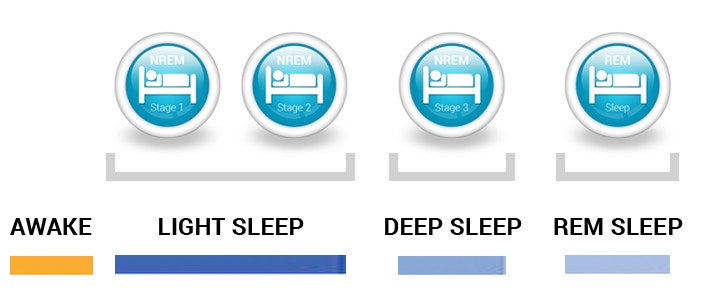
Stage 1
Stage 1 is the stage you enter when you start to nod off and your eyes close. This stage lasts between one and ten minutes. It is also known as “transitional sleep”, and during this stage, you can quickly return to being fully awake. Your eyes move slowly under the eyelids and muscle activity slows down.
Stage 2
Next comes Stage 2 which is known as “light sleep”. It lasts about twenty minutes. This is where we spend most of our nights (about 45% of total sleep). During this second stage, your heart rate slows, your muscles contract and relax, and your body temperature decreases as you prepare to go into deep sleep.
Stage 3
The 3rd stage is also known as “deep sleep” – in this stage it’s difficult to awaken, and if you forcibly wake up, you do not adjust immediately and often feel groggy and disoriented for several minutes. In this deepest stage of sleep, your brain waves are extremely slow. Blood flow is directed away from your brain and towards your muscles, restoring physical energy.
REM sleep
REM sleep is where dreams occur and the time to get there is approximately 70 to 90 minutes after falling asleep. Your eyes move rapidly, your breathing shallows, and your heart rate and blood pressure increase. During this stage, your arm and leg muscles are paralyzed.
Optimizing Your Sleep
| Age Group | Recommended Sleep Hours |
|---|---|
| newborn to 2 months old | 12 - 18 hours |
| 3 months to 1 year old | 14 - 15 hours |
| 1 to 3 years old | 12 - 14 hours |
| 3 to 5 years old | 11 - 13 hours |
| 5 to 12 years old | 10 - 11 hours |
| 12 to 18 years old | 8.5 - 10 hours |
| Adults (18+) | 7.5 - 9 hours |
You should calculate your sleep time based on what time you need to wake up using this calculator. You can also find out your ideal wake-up time based on the time you usually go to sleep.
It is essential to note that everything is calculated in cycles, rather than hours and minutes. So we need to get accustomed to think of sleep in cycles.
- The average sleep cycle is 90 minutes long
- A typical night of sleep includes 5 full sleep cycles
- 90 x 5 = 450 minutes, or 7.5 hours
For example: You need to wake at 6 a.m. to get ready for work. Counting back 7.5 hours, your ideal bedtime is 10:30 p.m. That means lights out, in bed, and ready for sleep at that time.
In a week there are therefore 35 full sleep cycles that we should ideally be getting. Life can and will interfere with our sleep cycles, so we need to learn how to deal with it.
For example, say you went to a friend’s birthday party and arrived back home at 2 am, what do you do? First, you think about what time you need to wake up the next day, say 7 am for work. That leaves us with 5 hours in between. Given that every sleep cycle is 90 minutes, we can fit 3 sleep cycles.
Therefore you should go to sleep at 2.30 am. This is where many people make a mistake. Typically you will just get home, have a shower and slump into bed, only looking at the clock to make sure the alarm is set for 7 am. The problem is that if you go to sleep before 2.30 am in this case, at 7 am you will already be in your 4th sleep cycle.
You will, of course, interrupt that cycle because your alarm will ring, and you’ll wake up feeling very groggy. This is the counterintuitive part, by actually sleeping a bit less you will wake up feeling better. We must not forget that we missed two missed cycles, however. Ideally, we would recover them in the following days to make sure that we keep our total of 35 sleep cycles per week.
The goal is to wake naturally about 5-10 minutes ahead of your alarm. If you absolutely need to wake up at a specific time, I still recommend using an alarm clock, but you should find that you wake up at around that time naturally, or at least feel very refreshed and ready to go when the alarm sounds. For a more natural wake up I suggest using the Philips HF3520 clock.
Sleep Efficiency
Implementing the sleep cycles doesn’t work if our quality of sleep is bad. This could be due to a bad mattress for example, or even sleeping in bad positions.
That’s why we need to be looking at sleep efficiency.
There’s an easy, low-tech way to measure sleep efficiency that requires no sleep tracking devices or equipment. You need only a few basic pieces of information about your night of sleep:
- The total amount of time you spend in bed sleeping—or trying to sleep—between bedtime and waking
- How long it takes you to fall asleep
- The amount of time you spent awake during the night
Let’s say you spent a total of 7 hours, or 420 minutes, in bed last night.
It took you 25 minutes to fall asleep.
You spent another 25 minutes awake throughout the night, a result of three separate periods of wakefulness.
Here’s how to calculate your sleep efficiency for this night:
- Total sleep time: 420 minutes
- Minus time to fall asleep: 25 minutes
- Minus total time spent awake: 25 minutes
- Actual time spent sleeping: 370 minutes (6 hours, 10 minutes)
Divide 370 minutes by 420 minutes = 88%. This number represents your sleep efficiency for that night.
In sleep science, we consider 85% or higher a healthy sleep efficiency and a reasonable goal. Ninety percent is considered a very good sleep efficiency. If your number isn’t quite there yet, don’t be discouraged. With attention to your sleep—and a new bedtime—you’ll see this important number start to rise.
You can find iPhone and Android apps that measure your sleep and calculate your sleep efficiency. I use my Fitbit to take these measurements.
Napping
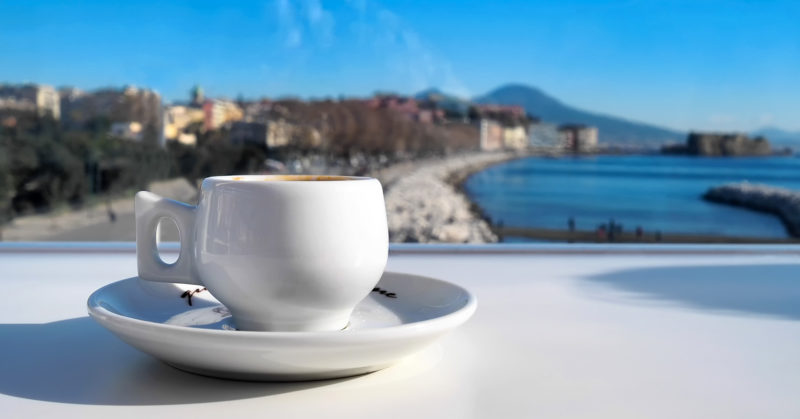
There are many studies that prove the effectiveness of a mid-day nap. Of course, we all know that many cultures (for example Spain) have the afternoon siesta deeply ingrained in them, and it looks like they are right in maintaining this old tradition. These cultures tend to have a split-day sleeping pattern of five to six hours and night and sixty to ninety minutes in the afternoon.
Napping also typically happens during the warmest period of the day and generally follows a large mid-day meal, which explains why afternoon sleepiness is so often associated with warm afternoon sun and heavy lunches.
Following a nap, having dissipated some of the accumulated sleep drive, many people report feeling better able to stay awake and alert in the late afternoon and evening. This increased alertness typically causes people to go to bed later and generally to sleep less at night than people who do not take naps.
Research at NASA demonstrated that pilots who had a 26-minute nap in the cockpit were more alert — by 54 percent — and had improved performance by 34 percent. Studies using advanced tools such as functional magnetic resonance imaging (fMRI) also have found performance benefits for nappers. Studies have even suggested that napping may produce the same memory gains as a full night’s slumber, as shown on tasks that tested declarative memory, motor memory and spatial memory.
You don’t need to nap for hours, 25 minutes is actually the ideal time.
If you try it and feel groggy when waking up, try this variation. Take a cup of coffee before hitting the bed. The caffeine will kick into action in 25 minutes, just when you are waking up, and give you a boost.
In general, experts recommend sleeping between 1 p.m. and 3 p.m. or between 2 p.m. and 4 p.m
You can use the table below (based on the Nap Wheel) to find out the best time to take a nap, based on your wake-up time.
| Wake up time | Perfect nap time |
|---|---|
| 6:00 am | 1:30 pm |
| 6:30 am | 1:45 pm |
| 7:00 am | 2:00 pm |
| 7:30 am | 2:15 pm |
| 8:00 am | 2:30 pm |
| 8:30 am | 2:45 pm |
| 9:00 am | 3:00 pm |
Why Do We Sleep Anyway?
While the brain sleeps, it clears out harmful toxins, a process that may reduce the risk of Alzheimer’s, researchers say.
During sleep, the flow of cerebrospinal fluid in the brain increases dramatically, washing away harmful waste proteins that build up between brain cells during waking hours, a study of mice found.
“It’s like a dishwasher,” says Dr. Maiken Nedergaard, a professor of neurosurgery at the University of Rochester and an author of the study in Science.
The results appear to offer the best explanation yet of why animals and people need sleep. If this proves to be true in humans as well, it could help explain a mysterious association between sleep disorders and brain diseases, including Alzheimer’s.
Read more about the study here.
Setting Up The Right Sleep Environment
You can read my article about designing your bedroom as a recovery room for more details, but here are some quick tips:
- Buy the right mattress for your weight.
- Keep the mattress and all linen and pillows clean.
- Keep the room at a cool temperature with a good supply of air.
- Take advantage of the morning sunlight, but make sure it’s dark when you go to sleep. You can buy the Philips clock and sunrise simulator if you don’t have the ideal conditions.
- Remove all electronic devices from your bedroom, especially phones and tablets.
- For blocking out light you can use an eye mask. Cheap and does the job.
- As an alternative to Mack ear buds (my favorite for blocking noises) is to use a white noise track off Spotify. It helps your brain go to sleep, in the same way that airplane or car noise does.
Tips for a great start to the day
- Drink two glasses of water as soon as you wake up. It’s best to have it with a few drops of lemon and Himalayan salt.
- Establish a morning routine. I have found that going outside, meditation, stretching, and preparing a cup of matcha or coffee works best for me, together with having a hearty breakfast.
- Prepare your work schedule the previous evening, and start with the most important task of the day (eating the frog).
I’d also add a bit of a longer note on exercise. Many people swear by morning exercise, while others absolutely can’t do it, and prefer an afternoon or evening session. I’ve experimented with this for a long time and have come to the conclusion that we all have our own best times for exercise.
People can be assigned to two broad groups: larks (people who go to bed early and rise early) and owls (people who go to bed late and rise late).
This time preference affects all biological rhythms, including the ability to exercise and perform. In general, it seems the best athletic performance is achieved late afternoon/early evening when several exercise-related rhythms reach their circadian peak. This means exercising at this time has the best results for increasing fitness, increasing lean muscle, and reducing fat tissue.
That’s pretty much what current science tells us, and there still is a lot of debate around this topic. My take is that you should train whenever it feels best for you. Personally, first thing in the morning is absolutely the best time for me. I love going out in the morning and really taking in the day, so a morning swim or cycle feels really awesome.
It wouldn’t be the same later in the day. Moreover, I have more control over my training duration than I have on my work sessions. I might start something really interesting in my office and feel absolutely no desire to leave my desk and go to train, and that led to many missed training sessions and lots of guilt in the past.
The only exception to training in the morning is if I have a scheduled match or group exercise activity. Having that extra responsibility of being part of a group and having paid for an activity magically gives me the willpower to train at any time of the day including late evenings or afternoons. Therefore, I combine morning sessions of padel training, gym work, swimming or cycling with afternoon and evening padel, indoor cycling, yoga/pilates.
Knowing Your Chronotype
There are four recognized chronotypes, and knowing which one you are can help you optimize your day, including sleep, exercise times and working hours. I am a Lion, so here’s my ideal sleep time calculation:
Sleep duration: Usually 5 cycles x 90 min = 450 min + 20 min to fall asleep = 470 min
Sleep time: up at 6:00am – 470 min = 10:10 pm
By tracking my sleep using a Fitbit, I have found that I feel best the next day when I sleep at least 7h45min as marked in the sleep reports.
The Alternative View
For a contrarian view on sleep science, you can read this post. I think it’s always healthy to be wary of the hype around a particular topic, and inspect the incentives that drive sleep scientists in this case. Are they promoting a book, speaking tour, podcast, consultancy etc? While that doesn’t mean they are lying about anything, you know they are incentivized to find some issue with your sleep even when there might be more important issues affecting your well-being.
I have personally experimented with sleep quite a bit, and invariably I feel at my best if I sleep 7-9 hours. If I sleep on the lesser end of a scale, then I need a nap to refresh half way through the day.
Experimenting with sleep monitoring gadgets was fun, but ultimately once you get the basics right and you’re in tune with your body, you will instinctively know when you’re doing it right and when you need to make some adjustments.
Further Resources
- Sleep by Nick Littlehales and his coaching services website.
- Why we Sleep by Matthew Walker
- Philips clock and sunrise simulator
Enjoy your sleep! Let me know whether you find this helpful and whether you have any other tips on sleep and rest routines.

